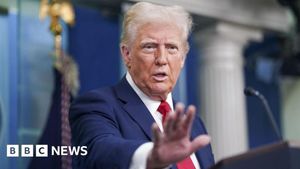U.S. stock markets faced significant losses on February 1, 2025, following the announcement from President Donald Trump’s administration of impending tariffs on imports from Mexico, Canada, and China. The announcement, made by White House Press Secretary Karoline Leavitt, confirmed 25% tariffs on goods from both Mexico and Canada, alongside a 10% tariff on goods from China. This news reignited fears of trade wars with some of the nation’s closest trading partners.
The tariffs are scheduled to take effect immediately, marking another contentious chapter in the U.S.'s trading policies. The Dow Jones Industrial Average fell by 337.47 points, or 0.8%, closing at 44,544.66, whilst the S&P 500 index dropped 30.64 points, or 0.5%, settling at 6,040.53. The Nasdaq Composite, which remained positive earlier, also slipped, finishing down 0.3% at 19,627.44.
This unsettling news overshadowed more optimistic data released earlier on the same day, which had momentarily buoyed investor sentiment. For much of Friday, strong earnings from tech giant Apple and positive results from inflation readings lent hope to traders, who had seen demonstrations of resilient consumer spending. Apple had reported stronger-than-expected earnings, but its stock slipped 0.7% by day’s end amid falling iPhone sales.
Despite these mixed signals, market watchers pointed to growing concerns surrounding the impact these tariffs may have on the U.S. economy. Scott Wren, senior global market strategist at Wells Fargo Investment Institute, noted, "Clearly, it makes total sense... they're not in a hurry to lower rates,” reflecting the sentiment among investors as they assess the situation.
The tariffs are part of Trump’s broader strategy, aimed at addressing what he perceives as trade imbalances detrimental to the U.S. economy. His administration has previously hinted at such actions, raising market speculation about the potential fallout. Following the relief provided by earlier positive economic data, the newly introduced tariffs turned market confidence on its head.
José Torres, senior economist at Interactive Brokers, highlighted the broader economic climate, emphasizing, "Some of the consumption buoyancy is thanks to... powerful wage growth,” which indicates parts of the U.S. economy remain strong. Yet, the looming tariffs have complicated forecasts, leading to uncertainty about inflation and the Federal Reserve’s interest rate policy.
Traders had been cautious heading toward this announcement, with discussions surfacing around how U.S. businesses might respond to these tariffs, especially those heavily reliant on imports. The imposition of tariffs could deter trade with key partners and prompt retaliatory measures, complicate supply chains, and potentially lead to increased prices for consumers.
While some sectors, particularly technology and energy, managed gains earlier, they too could face dire consequences stemming from reduced international collaboration. For example, Chevron, which reported disappointing earnings, saw its stock fall by 4.5% as the energy sector faced heightened pressure amid these announcements.
The immediate aftermath of this announcement has led many to reassess the market’s direction for the first quarter of 2025. Volatility is expected to remain as traders navigate this new complexity, balancing positive quarterly earnings against trade uncertainties. Stocks have already shown mixed results throughout the beginning of the year due to various factors, including concerns about Chinese tech advancements.
The broader reflection of market confidence can be observed as traders reconcile their positions following the February month’s first trading session. The S&P 500 had managed to increase 2.7% for January, primarily driven by strong corporate earnings. Nevertheless, this forward momentum is now at risk of being undermined by tariff impacts.
The new tariffs are positioned against the backdrop of recent economic resilience reflected by rising consumer incomes and spending, which reported increases of 0.4% and 0.7%, respectively, last December, according to reports. This data initially provided an encouraging perspective to the markets, though the results appear now clouded as investors react to tariff-related uncertainties.
With impending deadlines and uncertainty swirling, it remains to be seen how the markets will adapt. Investors and analysts are closely monitoring not just the announced tariffs but any retaliatory actions from affected countries, as these responses could play significant roles in determining market trends moving forward.
Investors continue to remain vigilant, as the Federal Reserve's next steps could also significantly shape the market's future. With the latest reading of the Fed’s preferred inflation gauge matching economist expectations, speculation around future interest rate cuts remains ambiguous, and traders are left to weigh increasing tariff pressures against enduring economic growth narratives.
With the uncertainty surrounding the tariffs and their potential fallout, many experts suggest maintaining caution. The balance between fostering strong corporate performance and mitigating trade complications will be pivotal for investors as they navigate these turbulent waters.
The stock market's performance on February 1 serves as just the beginning of what could be another tumultuous chapter of economic relations underscored by Trump's tariff measures. Only time will reveal the ultimate impacts on the broader economy and investor confidence.



